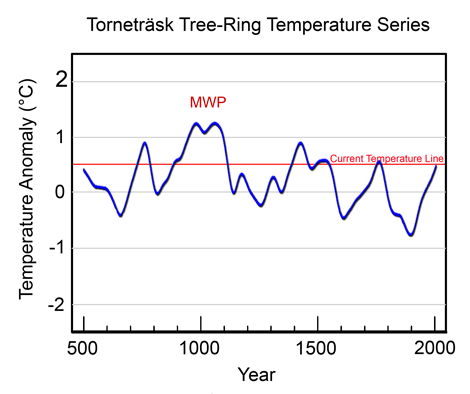Reference
Grudd, H. 2008. Tornetrask tree-ring width and density AD 500-2004: a test of climatic sensitivity and a new 1500-year reconstruction of north Fennoscandian summers. Climate Dynamics: 10.1007/s00382-0358-2.
Background
Noting that many tree-ring-based climate histories terminate far short of the end of the 20th century, Grudd states "there is an urgent need to update existing tree-ring collections throughout the northern hemisphere," especially (as his results vividly demonstrate) to make valid comparisons of past high-temperature periods, such as the Medieval Warm Period, with those the present, i.e., the Current Warm Period.
What was done
Working with an extensive set of Scots pine (Pinus sylvestris L.) tree-ring maximum density (MXD) data from the Tornetrask area of northern Sweden, which were originally compiled by Schweingruber et al. (1988) and covered the period AD 441-1980, Grudd extended the record an additional 24 years to 2004 using new samples obtained from 35 relatively young trees, which had the effect of reducing the mean cambial age of the MXD data in the 20th century and thus eliminating a disturbing "loss of sensitivity to temperature, apparent in earlier versions of the Tornetrask MXD chronology (Briffa, 2000)."
What was learned
The results of Grudd's efforts are presented in the following figure.

Figure 1. Annual April-August temperatures. Adapted from Grudd (2008).
What it means
Grudd concludes, as is readily evident from the results presented in the figure above, that "the late-twentieth century is not exceptionally warm in the new Tornetrask record," since "on decadal-to-century timescales, periods around AD 750, 1000, 1400 and 1750 were all equally warm, or warmer." More specifically, he notes that "the warmest summers in this new reconstruction occur in a 200-year period centered on AD 1000," leading him to state that "Fennoscandia seems to have been significantly warmer during medieval times as compared to the late-twentieth century," and that this period "was much warmer than previously recognized." In addition, he notes that "a warm period around AD 1000 is in line with evidence from other proxy indicators from northern Fennoscandia," writing that "pine tree-limit (Shemesh et al., 2001; Helama et al., 2004; Kulti et al., 2006) [and] pollen and diatoms (Korhola et al., 2000; Seppa and Birks, 2002; Bigler et al., 2006) show indisputable evidence [our italics] of a 'Medieval Warm Period' that was warmer than the twentieth century climate."
References
Bigler, C., Barnekow, L., Heinrichs, M.L. and Hall, R.I. 2006. Holocene environmental history of Lake Vuolep Njakajaue (Abisko National Park, northern Sweden) reconstructed using biological proxy indicators. Vegetation History and Archaeobotany 15: 309-320.
Briffa, K.R. 2000. Annual climate variability in the Holocene: interpreting the message of ancient trees. Quaternary Science Reviews 19: 87-105.
Helama, S., Lindholm, M., Timonen, M. and Eronen, M. 2004. Dendrochronologically dated changes in the limit of pine in northernmost Finland during the past 7.3 millennia. Boreas 33: 250-259.
Korhola, A., Weckstrom, J., Holmstrom, L. and Erasto, P. 2000. A quantitative Holocene climatic record from diatoms in Northern Fennoscandia. Quaternary Research 54: 284-294.
Kulti, S., Mikkola, K., Virtanen, T., Timonen, M. and Eronen, M. 2006. Past changes in the Scots pine forest line and climate in Finnish Lapland: a study based on megafossils, lake sediments, and GIS-based vegetation and climate data. The Holocene 16: 381-391.
Schweingruber, F.H., Bartholin, T., Schar, E. and Briffa, K.R. 1988. Radiodensitometric-dendroclimatological conifer chronologies from Lapland (Scandinavia) and the Alps (Switzerland). Boreas 17: 559-566.
Seppa, H. and Birks, H.J.B. 2002. Holocene climate reconstructions from the Fennoscandian tree-line area based on pollen data from Toskaljavri. Quaternary Research 57: 191-199.
Shemesh, A., Rosqvist, G., Rietti-Shati, M., Rubensdotter, L., Bigler, C., Yam, R. and Karlen, W. 2001. Holocene climatic change in Swedish Lapland inferred from an oxygen-isotope record of lacustrine biogenic silica. The Holocene 11: 447-454.
Reviewed 10 September 2008



